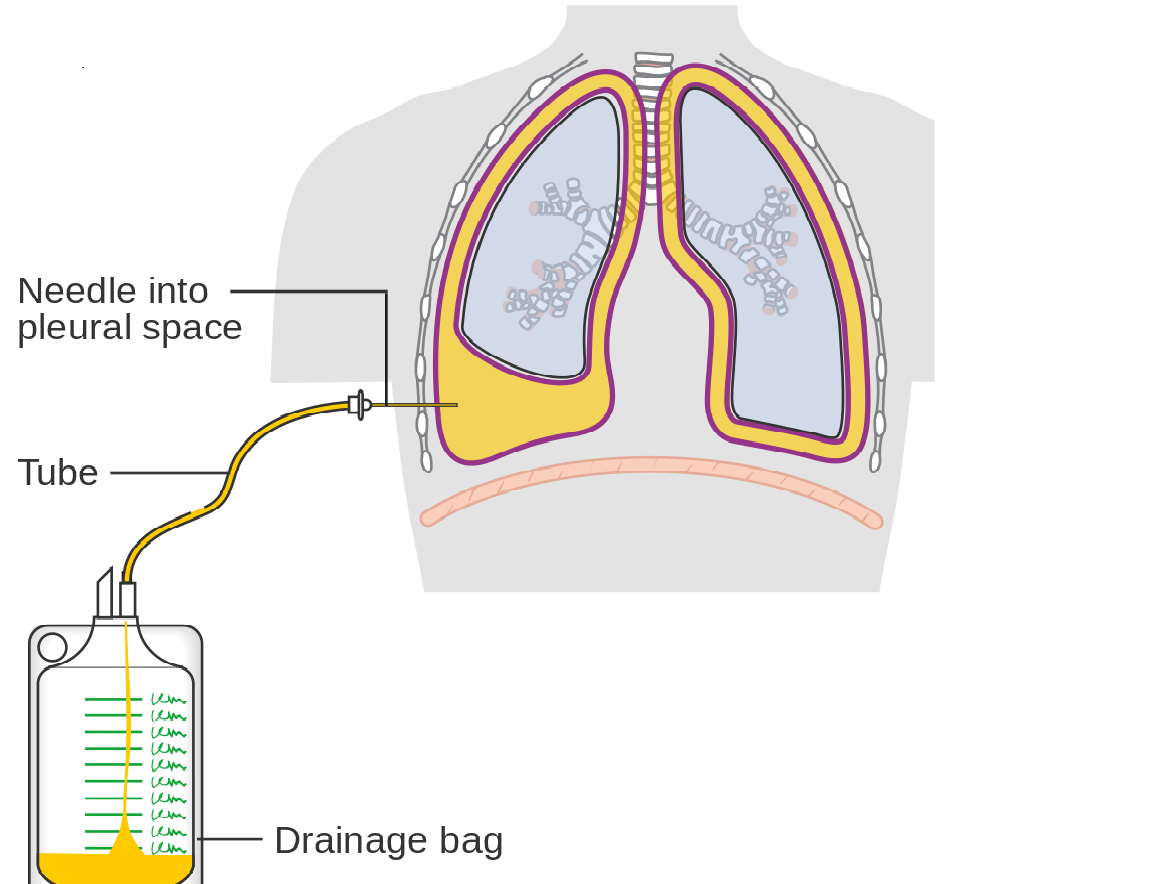

Patients with malignant (cancerous) pleural effusions (buildup of excess fluid in the pleural space, the space between the visceral and parietal lining of the lung) have significant shortness of breath, cough, chest pain and shortened life expectancy.
Indwelling pleural catheters (IPC) allow patients to drain pleural fluid at home and can lead to “autopleurodesis” (spontaneous cessation of pleural drainage without the use of other invasive procedures). Pleurodesis is a medical procedure in which the pleural space is artificially obliterated, involving the adhesion of the two lung linings so that fluid can no longer accumulate (See picture from JAMA).
 IPC involves placement of a silicon catheter with its distal part residing the pleural space, middle part tunnel under the skin and the proximal part laying outside the body and accessible for drainage (see picture from JAMA).
IPC involves placement of a silicon catheter with its distal part residing the pleural space, middle part tunnel under the skin and the proximal part laying outside the body and accessible for drainage (see picture from JAMA).
Earlier studies, comparing IPC with the in-hospital procedure like chemical pleurodesis using talc or doxycycline via tube thoracostomy, found them equally effective in relieving dyspnea with the included advantage of outpatient placement and management.
The optimal drainage frequency to achieve autopleurodesis and freedom from catheter has not been determined. The objective of this study was to determine whether an aggressive daily drainage strategy is superior to the current standard every other day drainage of pleural fluid in achieving autopleurodesis. This clinical trial was called ASAP (impact of Aggressive versus Standard drainage regimen using long-term IPC).
This was a randomized trial (people participating in the trial are randomly allocated to either the group receiving the treatment under investigation or to a group receiving standard treatment or placebo as the control), single-blinded (the individual subjects do not know whether they are so-called “test” subjects or members of the “control” group). and performed in multiple centers in the USA from 2009 to 2013.
Patients were randomized to either an aggressive drainage (daily drainage; a total of 73 patients) or standard drainage (every other day drainage; a total of 76 patients) of pleural fluid via a tunneled pleural catheter. Individuals in this study were adults with a malignant pleural effusion with different types of cancer.
The drainage of fluid was performed at home by a visiting nurse or a family member, after attending an education session at the time of placement and given written instruction, using vacuum bottles that can be attached to the catheter. Patients randomized to the standard drainage arm were instructed to drain a maximum of 1 L of pleural fluid every other day. Patients in the aggressive arm were instructed to drain a maximum of 1 L of pleural fluid on a daily basis.
The primary outcome was the presence of autopleurodesis following the placement of the indwelling pleural catheters. The rate of autopleurodesis, defined as a complete or partial response based on symptomatic and radiographic changes, was greater in the aggressive drainage arm than the standard drainage arm (47% vs. 24%, respectively).
Median time to autopleurodesis was shorter in the aggressive arm (median time to pleurodesis was 54 days) as compared with the standard arm (median time of 90 days). The rate of adverse events, quality of life, and patient satisfaction were not significantly different between the two arms.
In conclusion, daily drainage of pleural fluid via an IPC in patients with malignant pleural effusion led to a higher rate of autopleurodesis and faster time to liberty from the catheter.
more recommended stories
 Fat-Regulating Enzyme Offers New Target for Obesity
Fat-Regulating Enzyme Offers New Target for ObesityKey Highlights (Quick Summary) Researchers identified.
 Gestational Diabetes Risk Identified by Blood Metabolites
Gestational Diabetes Risk Identified by Blood MetabolitesKey Takeaways (Quick Summary for Clinicians).
 Pelvic Floor Disorders: Treatable Yet Often Ignored
Pelvic Floor Disorders: Treatable Yet Often IgnoredKey Takeaways (Quick Summary) Pelvic floor.
 Circadian Control of Neutrophils in Myocardial Infarction
Circadian Control of Neutrophils in Myocardial InfarctionKey Takeaways for HCPs Neutrophil activity.
 E-Cigarette Use and Heart Attack Risk in Former Smokers
E-Cigarette Use and Heart Attack Risk in Former SmokersKey Takeaways for Clinicians and Nurses.
 Ultramarathon Physiology: What HCPs Should Know?
Ultramarathon Physiology: What HCPs Should Know?Ultramarathon Metabolism: What Happens to the.
 High-Intensity Training and Oxidative Stress Insights
High-Intensity Training and Oxidative Stress InsightsNew Evidence Linking High-Intensity Training and.
 Sterilized Fermented Beverage for Obesity: New Evidence
Sterilized Fermented Beverage for Obesity: New EvidenceEarly Insights Into a Sterilized Fermented.
 Cardiovascular Risk and Sudden Cardiac Death in Diabetes
Cardiovascular Risk and Sudden Cardiac Death in DiabetesRising Sudden Cardiac Death (SCD) Risk.
 Perinatal Mental Health Challenges Highlighted in New Study
Perinatal Mental Health Challenges Highlighted in New StudyMental Health Challenges in New Parents:.

Leave a Comment